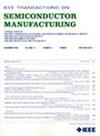利用人工神经网络识别 "坏邻居 "中的 "好伙伴
IF 2.3
3区 工程技术
Q2 ENGINEERING, ELECTRICAL & ELECTRONIC
引用次数: 0
摘要
众所周知,确定 "好骰子在坏邻居中"(GDBNs)一直被认为是通过识别和剔除可疑骰子(即使这些骰子在测试中是好的)来降低百万分之缺陷率(DPPM)值的有效技术。与在一个 3/3 乘 3$ 的小窗口中检查八个近邻或利用简单的线性回归不同,可以使用一个大窗口来识别广视角邻域,并准确推断任何给定骰子的可疑程度。本文提出了基于人工神经网络(ANN)的方法来解决 GDBN 识别问题。此外,本文还进一步提出了两种增强技术,通过考虑随时间变化的晶圆图案和相邻两个晶圆之间的晶圆与晶圆关系的变化,来提高基于人工神经网络的原始方法的推断精度。应用这两项增强技术后,基于 ANN 的新方法可以提高商业利润。在两个数据集上进行的各种实验清楚地揭示了所提出的基于 ANN 的方法优于其他现有方法。除了降低 DPPM 值,基于 ANN 的新方法还能使退货授权(RMA)成本降低 1.5 倍至 2 倍。另一方面,实验结果表明,其他低收益产品也能获得类似的结果。通过使用基于 ANN 的新方法,可以捕捉到坏骰子交叉晶圆的关系,并同时保持高精度的推理结果。本文章由计算机程序翻译,如有差异,请以英文原文为准。
Identifying Good-Dice-in-Bad-Neighborhoods Using Artificial Neural Networks
It is known that the determination of the good-dice-in-bad-neighborhoods (GDBNs) has been regarded as an effective technique to reduce the value of the defect parts per million (DPPM) by identifying and rejecting the suspicious dice even though they are good in testing. Instead of examining eight immediate neighbors in a small-sized
$3\times 3$
window or exploiting simple linear regression, a large-sized window can be used to recognize the broad-sighted neighborhoods and accurately infer the suspiciousness level for any given die. In this paper, the artificial neural networks (ANN)-based method can be proposed to solve the GDBN identification. Furthermore, two enhanced techniques can be further presented to improve the inference accuracy of the original ANN-based method by considering the variation of the time-dependent wafer patterns and the wafer-to-wafer relationship between two adjacent wafers. After applying the two enhanced techniques, the business profits can be improved in the new ANN-based method. Various experiments on two datasets clearly reveal the superiority of the proposed ANN-based method over the other existing methods. In addition to the reduction of the DPPM value, the new ANN-based method can achieve the 1.5X–2X better reduction in the cost of the return merchandise authorization (RMA). On the other hand, the experimental results show that the similar result can also be obtained in the other lower-yield products. By using the new ANN-based method, the relationships on bad dice cross wafers can be captured and the highly-accurate inference results can be simultaneously maintained.
求助全文
通过发布文献求助,成功后即可免费获取论文全文。
去求助
来源期刊

IEEE Transactions on Semiconductor Manufacturing
工程技术-工程:电子与电气
CiteScore
5.20
自引率
11.10%
发文量
101
审稿时长
3.3 months
期刊介绍:
The IEEE Transactions on Semiconductor Manufacturing addresses the challenging problems of manufacturing complex microelectronic components, especially very large scale integrated circuits (VLSI). Manufacturing these products requires precision micropatterning, precise control of materials properties, ultraclean work environments, and complex interactions of chemical, physical, electrical and mechanical processes.
 求助内容:
求助内容: 应助结果提醒方式:
应助结果提醒方式:


